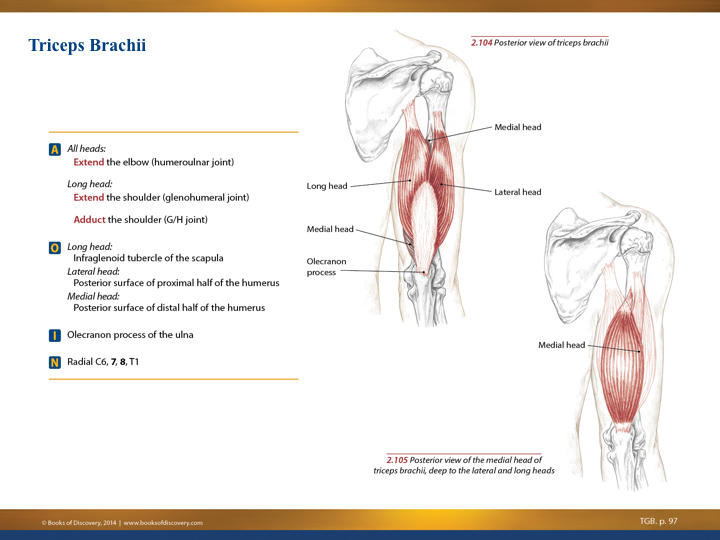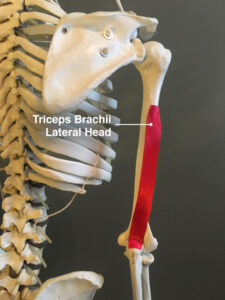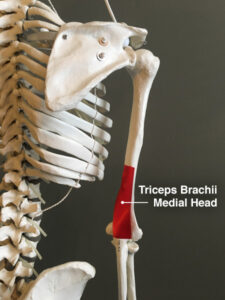What’s the difference between doing triceps extensions with a pronated grip, supinated grip and neutral?
This is a common question that arises about the many ways to strengthen the triceps. One of the exercises has more resistance from its antagonistic muscle group, biceps – meaning it might be a more challenging grip.
Anatomy helps us understand triceps extensions better. The body awareness that stems from anatomy knowledge makes imbalances in right to left side muscle recruitment easier to identify. Having symmetry in the body makes exercise more beneficial because there is better alignment. Misalignment often leads to injury.
Changing the way you position the dumbbell, band or cable changes which muscles are recruited, stabilizing and resisting. Understanding the four biceps muscles is also important when learning how the triceps muscles contract because they are on the other side of the joint resisting elbow extension.
An EMG is the only way to know for certain which muscles are working. But, you can call upon body awareness to get pretty close to knowing.
Anatomy of the Triceps Muscles
There are three triceps muscles in your arm. Knowing where each of these elbow extension muscles attaches creates awareness when exercising.
Find each attachment on yourself and on a partner. Use a balloon on a partner to deepen your understanding.
Click the name of each muscle for a short video.
Triceps Brachii Long Head – Lateral border of scapula to olecranon process of elbow
Triceps Brachii Lateral Head – Lateral humerus to olecranon process of elbow
Triceps Brachii Medial Head – Medial humerus to olecranon process of elbow

What is happening in each triceps exercise position?
Supinated Grip Triceps Extension
Your palms are facing the anterior or front of the body in this grip. Anatomically, the radius and ulna are parallel to each other. All of the elbow extension muscles are lined up well to help with this exercise.
Grasp your elbow joint with your opposite hand, wrapping around it. The lateral head of the triceps seems to contract just by supinating so perhaps it has a larger role in this type of extension.
You can also feel the biceps tendon in your elbow pit become taught when supinated, meaning it might resist the motion a little more causing the tricpes muscles to create more force.
Neutral Grip Triceps Extension
Your palms are facing your sides throughout the entire motion in this grip. Place your hand on your proximal (close to elbow joint) radius and ulna. Feel what happens when you move from a supinated position to neutral. The radius stacks on top of the ulna. The biceps tendon is more relaxed meaning it might resist less.
Pronated Grip Triceps Extension
Your palms are facing the posterior or back side of the body in this grip. Remember how the radius and ulna were parallel in supination and stacked in the neutral grip? Now they are crossing over each other.
Grasp your elbow joint with your hand wrapping around it again as you pronate and supinate. Notice the muscles that are tightening when you do this.
Body and Triceps Awareness Exercise
Have you ever had a client who was stronger on one side than the other? Or who complained of discomfort when curling on one side and not the other? Knowing where the muscles attach, being aware of them and cueing are all connected to body awareness.
Try this. Ask a client where they feel muscles contracting in each of the three exercises above. Ask if they feel the same sensation on the right and left sides. Then, show them where the attachments are for each muscle and see if they can feel each muscle working. Review one at a time with them to keep it simple. Of course, try this for yourself first!
Triceps Exercise Variety
Aside from doing bilateral extensions (both arms at the same time) and unilateral extensions (one at a time) you can use bands or cables instead of dumbbells. What’s the difference?
The line of pull changes. Especially if you attach the band or cable in front of you versus attaching it up high above you. Different supporting muscles are recruited to stabilize when you change where the band is attached.
Of course, you can also make the repetitions slower, faster, pulse them or just hold the exercise in the hardest position (which is at 90 degrees).
Also, try starting with a neutral grip and rotate into a supinated or pronated grip by the time they get to the end of the motion.
I’d love to hear what you discovered when you worked on body awareness and feeling the triceps brachii muscles on your own body or what your clients are reporting when you help them explore. Please share with us on Facebook.
[info type=”facebook”]If you’re an NFPT trainer, join the Facebook Community Group and come share. If you’re not certified yet, come talk with NFPT here, we would like to meet you.[/info]
Get more hands-on experience with anatomy and body awareness.
Balloons, play-doh, pipe cleaners, and ribbons are used to demonstrate each muscle with its attachment point on a skeleton model in a series of videos. You’re also shown how to find the attachments on yourself and/or clients. Application exercises and guided visualizations are also provided along with a 50-page workbook.
References:
Abrahams, P.H. et al. 2003. McMinn’s Color Atlas of Human Anatomy. London: Elseiver.
Muscolino, Joseph E. 2004. Musculoskeletal Anatomy Coloring Book. Philadelphia, PA: Mosby, Inc.






